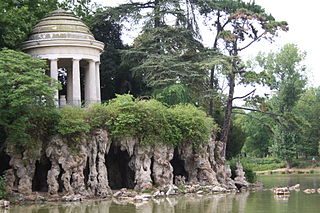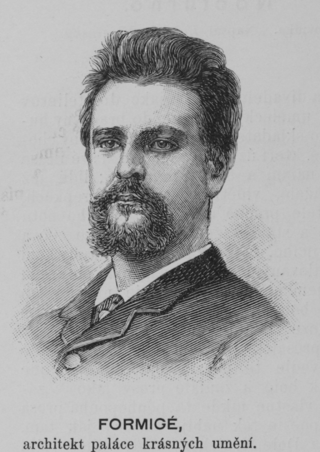
The Avenue des Champs-Élysées is an avenue in the 8th arrondissement of Paris, France, 1.9 kilometres (1.2 mi) long and 70 metres (230 ft) wide, running between the Place de la Concorde in the east and the Place Charles de Gaulle in the west, where the Arc de Triomphe is located. It is known for its theatres, cafés, and luxury shops; as the finish of the Tour de France cycling race; and for its annual Bastille Day military parade. The name is French for the Elysian Fields, the place for dead heroes in Greek mythology. It has been described as the "most beautiful avenue in the whole world".

The Jardin du Luxembourg, known in English as the Luxembourg Garden, colloquially referred to as the Jardin du Sénat, is located in the 6th arrondissement of Paris, France. The creation of the garden began in 1612 when Marie de' Medici, the widow of King Henry IV, constructed the Luxembourg Palace as her new residence. The garden today is owned by the French Senate, which meets in the palace. It covers 23 hectares and is known for its lawns, tree-lined promenades, tennis courts, flowerbeds, model sailboats on its octagonal Grand Bassin, as well as picturesque Medici Fountain, built in 1620. The name Luxembourg comes from the Latin Mons Lucotitius, the name of the hill where the garden is located, and locally the garden is informally called "le Luco".

The Bois de Vincennes, located on the eastern edge of Paris, France, is the largest public park in the city. It was created between 1855 and 1866 by Emperor Napoleon III.

The Bois de Boulogne is a large public park that is the western half of the 16th arrondissement of Paris, near the suburb of Boulogne-Billancourt and Neuilly-sur-Seine. The land was ceded to the city of Paris by the Emperor Napoleon III to be turned into a public park in 1852.

The Parc des Buttes Chaumont is a public park situated in northeastern Paris, France, in the 19th arrondissement. Occupying 24.7 hectares, it is the fifth-largest park in Paris, after the Bois de Vincennes, Bois de Boulogne, Parc de la Villette and Tuileries Garden.

The Avenue Foch is an avenue in the 16th arrondissement of Paris, France, named after World War I Marshal Ferdinand Foch in 1929. It was previously known as the Avenue du Bois de Boulogne. It is one of the most prestigious streets in Paris, as well as one of the most expensive addresses in the world, home to many grand city palaces, including ones belonging to the Onassis and Rothschild families. The Rothschilds once owned numbers 19–21.

Parc Monceau is a public park situated in the 8th arrondissement of Paris, France, at the junction of the Boulevard de Courcelles, Rue de Prony and Rue Georges Berger. At the main entrance is a rotunda. The park covers an area of 8.2 hectares.

Parc Montsouris is a public park situated in southern Paris, France. Located in the 14th arrondissement, it was officially inaugurated in 1875 after an early opening in 1869.

Jean-Camille Formigé (1845-1926) was a French architect during the French Third Republic. He served as the chief architect of historic monuments of France, and also as the chief architect of buildings, promenades and gardens of the city of Paris. His son, Jules Formigé, was also a prominent architect.

The Cours-la-Reine, also spelled Cours la Reine, is a public park and garden promenade located along the River Seine, between the Place de la Concorde and the Place du Canada, in the 8th arrondissement of Paris. It is one of the oldest parks in Paris, created in 1616 by Queen Marie de' Medici. The further extension of the garden between Place du Canada to Place d'Alma is called the Cours Albert Premier.

Jean-Pierre Barillet-Deschamps was a French horticulturist and landscape architect. He was the chief gardener of Paris during the reign of Emperor Napoleon III, and was responsible for planting the great gardens of the French Second Empire; the Bois de Boulogne, the Bois de Vincennes, Parc Montsouris, Parc des Buttes-Chaumont, the remaking of the Luxembourg Garden, and many smaller Parisian parks and gardens. He was also responsible for planting trees along the new boulevards of Paris. His landscape gardens, with their lakes, winding paths, sloping lawns, groves of exotic trees and flower beds, had a large influence on public parks throughout Europe and in the United States.

Paris today has more than 421 municipal parks and gardens, covering more than three thousand hectares and containing more than 250,000 trees. Two of Paris's oldest and most famous gardens are the Tuileries Garden, created in 1564 for the Tuileries Palace, and redone by André Le Nôtre in 1664; and the Luxembourg Garden, belonging to a château built for Marie de' Medici in 1612, which today houses the French Senate. The Jardin des Plantes was the first botanical garden in Paris, created in 1626 by Louis XIII's doctor Guy de La Brosse for the cultivation of medicinal plants. Between 1853 and 1870, the Emperor Napoleon III and the city's first director of parks and gardens, Jean-Charles Adolphe Alphand, created the Bois de Boulogne, the Bois de Vincennes, Parc Montsouris and the Parc des Buttes Chaumont, located at the four points of the compass around the city, as well as many smaller parks, squares and gardens in the neighborhoods of the city. One hundred sixty-six new parks have been created since 1977, most notably the Parc de la Villette (1987–1991) and Parc André Citroën (1992).

The Jardin des Champs-Élysées is a public park located in the 8th arrondissement of Paris. It occupies 13.7 hectares, and is located on both sides of the Avenue des Champs-Élysées between the Place de la Concorde on the east and the Rond-point des Champs-Élysées on the west and between Avenue Gabriel to the north and the Seine to the south. It includes within its boundaries the Grand Palais and the Petit Palais, as well as a theater and other buildings. It was one of the first parks in the city, laid out by André Le Notre in 1667, and was the site of the Paris International Exposition of 1855 and an important part of the Paris Universal Exposition of 1900, for which the Grand Palais and Petit Palais were created.

Parc Georges-Brassens is a public park located in the 15th arrondissement of Paris, between rue des Morillons and rue de Périchaux. Opened in 1984, it occupies 7.74 hectares on the site of a former fish market, horse market and slaughterhouse, and preserves some of the old market structures. It is named for the French popular singer Georges Brassens (1921–1981) who lived in the neighborhood of the park at 9 impasse Florimont and 42 rue Santos Dumont. The nearest metro stations to the park are Convention and Porte-de-Vanves.

The Parc de la Butte-du-Chapeau-Rouge formerly known as the Square de la Butte-du-Chapeau-Rouge, is a public park in the 19th arrondissement of Paris, which was created in 1939. It is an example of 1930s modernist park design, and contains a fountain and works of sculpture from the Exposition Internationale des Arts et Techniques dans la Vie Moderne (1937) held at the Trocadéro.

The Parc floral de Paris is a public park and botanical garden located within the Bois de Vincennes in the 12th arrondissement of Paris. Created in 1969, the park remains the legacy of the international horticultural exposition, which was organised under the auspices of the International Association of Horticultural Producers (AIPH) and recognised by the Bureau International des Expositions (BIE). It is one of four botanical gardens in Paris, and is the site of major annual flower shows. The nearest metro station to the park is Chateau-de-Vincennes.

Parc Kellermann is a public park located in the 13th arrondissement of Paris which was created between 1939 and 1950 on the former bed of the Bièvre river. The park is located between boulevard Kellermann, the rue de la Poterne-des-Peupliers, and rue Max-Jacob. The nearest metro station to the park is Porte-d'Italie.

The Jardin du Bassin de l'Arsenal is a public park in the 12th arrondissement of Paris, located on the east bank of the Canal Saint-Martin between the Place de la Bastille and the Seine. It was created in 1983. The access to the park is from boulevard de la Bastille. The nearest metro station is Bastille.
Parc des Bains is a park located in the region of Jura, in the Franche-Comté of eastern France. It was built under Camille Prost and was completed in 1904. In the late 19th century, Camille Prost wanted to create a spa in the city of Lons-le-Saunier, to showcase its salt water. The park, covering 7 hectares, was built to embellish the surrounding area and was designed by the French horticulturist and landscape architect H. Michel.





















